5 books about Kaiser, Michael M.
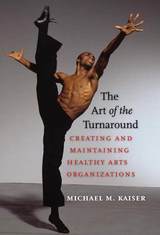
The Art of the Turnaround
Creating and Maintaining Healthy Arts Organizations
Michael M. Kaiser
Brandeis University Press, 2008
Many arts organizations today find themselves in financial difficulties because of economic constraints inherent in the industry. While other companies can improve productivity through the use of new technologies or better systems, these approaches are not available in the arts. Hamlet requires the same number of performers today as it did in Shakespeare’s time. The New York Philharmonic requires the same number of musicians now as it did when Tchaikovsky conducted it over one hundred years ago. Costs go up, but the size of theaters and the price resistance of patrons limit what can be earned from ticket sales. Therefore, the performing arts industry faces a severe gap between earnings and expenses. Typical approaches to closing the gap—raising ticket prices or cutting artistic or marketing expenses—don’t work. What, then, does it take to create and maintain a healthy arts organization? Michael M. Kaiser has revived four major arts organizations: the Kansas City Ballet, the Alvin Ailey American Dance Theater, American Ballet Theatre, and London’s Royal Opera House. In The Art of the Turnaround he shares with readers his ten basic rules for bringing financially distressed arts organizations back to life and keeping them strong. These rules cover the requirements for successful leadership, the pitfalls of cost cutting, the necessity of extending the programming calendar, the centrality of effective marketing and fund raising, and the importance of focusing on the present with a positive public message. In chapters organized chronologically, Kaiser brings his ten rules vividly to life in discussions of the four arts organizations he is credited with saving. The book concludes with a chapter on his experiences at the John F. Kennedy Center for the Performing Arts, an arts organization that needed an artistic turnaround when he became the president in 2001 and that today exemplifies in practice many of the ten rules he discusses throughout his book.
[more]
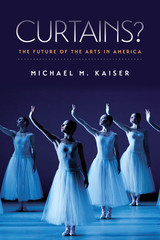
Curtains?
The Future of the Arts in America
Michael M. Kaiser
Brandeis University Press, 2015
In this clear-minded but sobering book, Michael M. Kaiser assesses the current state of arts institutions—orchestras; opera, ballet, modern dance, and theater companies; and even museums. According to Kaiser, new developments in the twenty-first century, including the Internet explosion, the death of the recording industry, the near-death of subscriptions, economic instability, the focus on STEM education in schools, the introduction of movie-theater opera, the erosion of newspapers, the threat to serious arts criticism, and the aging of the donor base have together created tremendous challenges for all arts organizations. Using Michael Porter’s model of industry structure to describe how industries evolve, Kaiser argues persuasively that unless steps are taken now, midsized performing arts institutions will have all but evaporated by 2035. Only the largest arts organizations will survive, with tickets priced for the very wealthy and programming limited to the most popular and lucrative productions. Kaiser concludes with a call to arms. With three extraordinary decades’ experience as an arts administrator behind him, he advocates passionately for risk-taking in programming and more creative marketing, and details what needs to happen now—building strong donor bases, creating effective boards, and collective action—to sustain the performing arts for generations to come.
[more]
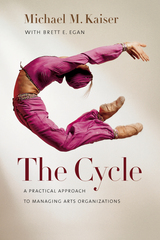
The Cycle
A Practical Approach to Managing Arts Organizations
Michael M. Kaiser and Brett E. Egan
Brandeis University Press, 2013
In the third book of his popular trilogy on creating and sustaining arts organizations, Michael Kaiser reveals the hidden engine that powers consistent success. According to Kaiser, successful arts organizations pursue strong programmatic marketing campaigns that compel people to buy tickets, enroll in classes, and so on—in short, to participate in the organization’s programs. Additionally, they create exciting activities that draw people to the organization as a whole. This institutional marketing creates a sense of enthusiasm that attracts donors, board members, and volunteers. Kaiser calls this group of external supporters the family. When this hidden engine is humming, staff, board, and audience members, artists, and donors feel confidence in the future. Resources are reinvested in more and better art, which is marketed aggressively; as a result, the “family” continues to grow, providing even more resources. This self-reinforcing cycle underlies the activities of all healthy arts organizations, and the theory behind it can be used as a diagnostic tool to reveal—and remedy—the problems of troubled ones. This book addresses each element of the cycle in the hope that more arts organizations around the globe—from orchestras, theaters, museums, opera companies, and classical and modern dance organizations to service organizations and other not-for-profit cultural institutions—will be able to sustain remarkable creativity, pay the bills, and have fun doing so!
[more]
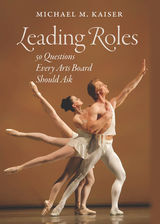
Leading Roles
50 Questions Every Arts Board Should Ask
Michael M. Kaiser
Brandeis University Press, 2010
Not-for-profit arts organizations struggled to survive the recent economic recession. In this increasingly hardscrabble environment, it is absolutely imperative that the boards of these organizations function as energetically, creatively, and efficiently as possible. Michael M. Kaiser’s personal history with boards of arts organizations began when he served on the board of the Washington Opera (now the Washington National Opera) in 1983. Today, in his capacity as president of the John F. Kennedy Center for the Performing Arts, Kaiser recently completed a 50-state, 69-city Arts in Crisis tour. Board issues came up repeatedly as central to the success or failure of the organization. Drawing on these and many other conversations, nationally and internationally, Kaiser’s book offers members of boards and staffs the information they need to create the healthy atmosphere necessary to thriving arts organizations. Organized in a clear, readable, question-and-answer format, Leading Roles covers every aspect of board participation in the life of the organization, including mission and governance; fundraising and marketing responsibilities; the relationship of the board to the artistic director, executive director, and staff; and its responsibilities for planning and budgeting. Kaiser addresses boards in crisis, international boards, and boards of arts organizations of color. Throughout, he emphasizes the importance of transparency and clarity in the board’s dealings with its own members and those of the arts community of which it is a part, showing how anything less results in contentiousness that can immobilize an arts organization, or even tear it apart.
[more]
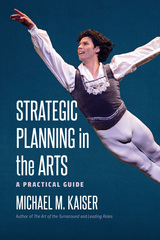
Strategic Planning in the Arts
A Practical Guide
Michael M. Kaiser
Brandeis University Press, 2018
Planning today is more important than ever. Both acquisition and allocation of resources are increasingly difficult for arts organizations as a result of emerging technologies, reduced arts education, aging donors, and the advent of new forms of entertainment. It is essential for arts organizations to take a coherent approach to these issues to remain vibrant over time. In fact, most arts organizations do periodically attempt some kind of planning exercise. But a review of hundreds of such plans suggests that most contain merely a wish list, rather than concrete plans for the future: “We will increase ticket sales!” is a common “strategy” expressed in too many arts plans. In the absence of details about how ticket sales will be increased, it’s an empty promise. In Strategic Planning in the Arts, Michael M. Kaiser, the former head of the Kennedy Center in Washington, DC, and an arts management guru, has produced a clear, concise guide for staff or board members of not-for-profit arts organizations who are responsible for developing, evaluating, or implementing plans. Relying on real-world cases and examples, Kaiser shows how to conceive, assess, and act on every part of the strategic plan, from the mission statement to the financial statement; from managing the board to marketing. Praise for Michael Kaiser: “A rich yet tidy cornucopia of solutions for the challenges facing the American arts scene.”—Washington Post
[more]
READERS
Browse our collection.
PUBLISHERS
See BiblioVault's publisher services.
STUDENT SERVICES
Files for college accessibility offices.
UChicago Accessibility Resources
home | accessibility | search | about | contact us
BiblioVault ® 2001 - 2024
The University of Chicago Press









